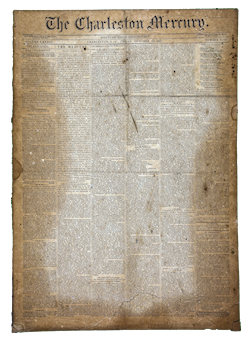March 1, 1861; The Charleston Mercury
In pursuance of regimental orders, the Seventeenth Regiment paraded yesterday afternoon for review. At three othe regiment formed in Broad street, the right resting upon Meeting street and the left upon Church street. We noticed the following mounted staff officers in command: Colonel JOHN CUNNINGHAM, Adjutant F. A. MITCHELL, Paymaster J. HOWARD, Quartermaster R. Q. PINCKNEY, and Surgeons PRIOLEAU and FITCH.
At half past three the regimental colors were taken from the Court House, and the regiment wheeled into line and marched through Meeting street to the Citadel Green, in the following order:
Staff.
Palmetto Brass Band.
Charleston Riflemen, Capt. JOHNSON, 58 men.
Irish Volunteers, Capt. MAGRATH, 65 men.
Sumter Guards, Capt. RUSSELL, 48 men.
Montgomery Guards Capt. CONNER, 70 men.
Palmetto Guards. Lieut. BREWSTER, 110 men.
Charleston Brass Band.
Color Guard with Regimental Colors.
German Fusiliers, Capt. LORD, 60 men.
Richardson Guard, Lieut. AXSON, 45 men.
Calhoun Guards, Capt. FRASER, 36 men.
Union Light Infantry, Capt. RAMSAY, 48 men.
Cadet Riflemen, Capt. ELLIOTT, 40 men.
Upon arriving at the Citadel Green, the regiment was formed into line in open order, and Brigadier General JAMES SIMONS appeared upon the ground, accompanied by his Staff Officers, and also under the special escort of the Rutledge Mounted Riflemen, Capt. HUGER, numbering 50 men. This fine company drew up on the extreme right, and the review began immediately. As the general staff passed the right of the line, the Palmetto band struck up the Marseillaise Hymn. When Gen. SIMONS had reached the centre of the regiment, where the colors were planted, the Charleston Band played “Hail to the Chief.” Upon the return of the reviewing officers to the starting point, the Palmetto Band again struck up. This time it was the glorious, rollicking air of “Dixieland,”which the popular taste, from Charleston to New Orleans, seems to have chosen as the nation tune of the South. At this moment the scene was a noble and inspiriting one; far across the green, in serried array, stretched the line of glistening bayonets, borne by sturdy grey coated forms that would do honor to any army. The Square was filled by a vast crowd of spectators, including numbers of ladies, while dotted here and there over the field were the gay plumes, glittering uniforms, and prancing charges of the officers.
Gen. SIMMONS and staff, having quitted the field with the escort of Mounted Riflemen, the Regiment went through a number of intricate field evolutions in creditable style. The line of march was taken up for the Battery, through King, Wentworth and Meeting streets. From the Battery the Regiment proceeded to the rendezvous on Broad street, where the companies were dismissed.
In a parade where all acquitted themselves so well, it is, perhaps, needless to particularize. But the very full ranks of the Palmetto Guards out hardly to pass unnoticed. We thought, also that we could perceive in the heavy, solid march and close ranks of the Irish Volunteers and other companies, the salutary effects of their long and faithful service and habitual drilling at the harbor defences. The flanking companies – the Charleston Riflemen and Cadet Riflemen – looked well, and performed their difficult parts in the manoeuvres with rapidity and skill. Altogether the parade was one of the finest military demonstrations that Charleston has seen for many a day.
